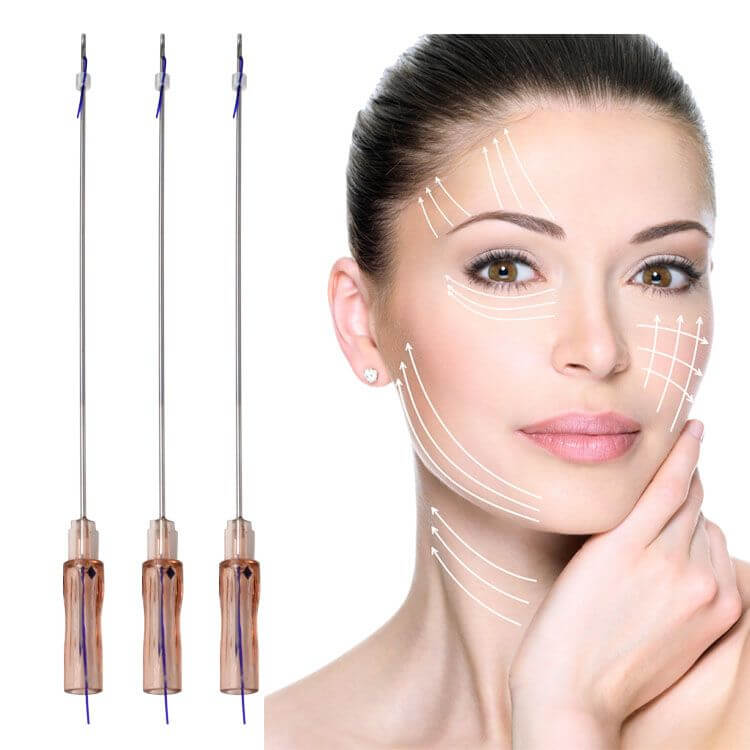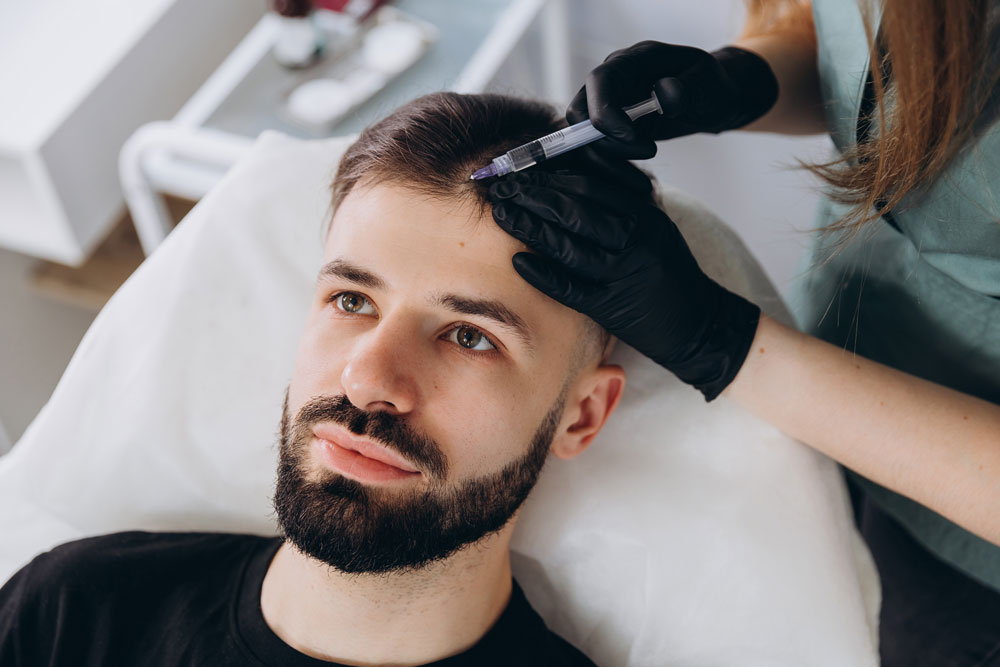None of us want to look as old as we actually are. Some of us even look older than our chronological age due to genetics, health conditions, smoking, excessive drinking or repeated unprotected sun damage. Whatever your reason for wanting to look younger, Advanced Aesthetics Las Vegas in Las Vegas, NV can help you look and feel better about yourself. We have the answers to all the questions you’ve wondered about the PDO thread lift, including how long the threads last and if it is right for you.
Frequently Asked Questions About PDO Thread lift
1. What Is PDO Thread lift?
A PDO thread lift is a revolutionary new treatment in the world of aesthetics, but PDO threads themselves have been used safely for decades for various applications, like treating gynecological disorders or suturing incisions after medical procedures. When used as an aesthetic treatment, there are a few things you should know.
First, it mechanically results in instant skin lifting. Second, it contracts fat tissue to result in instant skin tightening. Third, it promotes collagen production and neovascularization to renew your skin at the cellular level. All of this works together to give you enhanced skin texture, fewer fine lines and wrinkles and more elastic skin.
2. How Long Does It Take?
One of the best things about this treatment is it only takes 15 to 30 minutes. After that, you’re free to go back to work or whatever else you had scheduled for the rest of your day.
3. What Can I Expect Before Treatment?
Before treatment starts, we will apply a topical numbing agent and local anesthetic to the treatment site. The needle used during this treatment is so fine it will not cause any pain. However, we provide anesthesia to ensure you feel no discomfort during the treatment.
4. What Can I Expect During Treatment?
Once the anesthetic has taken effect, your treatment will begin. The PDO threads are inserted via blunt tip needles, called cannulas, or sharp-tipped needles. Once inserted into the appropriate layer of skin, they act as anchors as the skin is lifted upwards. Then, the excess threads are cut off.
5. Are All PDO Threads the Same?
There are several types of PDO threads, and each serves its own unique purpose. Depending on your aesthetic goals, your PDO provider may use one or many thread types during your anti-aging treatment.
6. What Types of PDO Threads Are There?
There are two primary types of PDO threads, These are floating non-barbed threads and floating barbed threads. Sub-classifications of non-barbed threads include braided threads and mono-filament threads. Sub-classifications of barbed threads include:
- Unilateral
- Bilateral
- Spiral
- Uni-directional
- Bi-directional
- Z-type
- Cutting barbs
- Molding barbs
You may hear PDO threads described with names such as “heart barbs”, “tornado” or “double screw”. These are all references to various barbed PDO threads.
7. Does It Really Matter What Kind of PDO Thread Is Used?
It absolutely matters what type or types are PDO thread is used during your PDO thread lift. Besides the distinct difference in shape, PDO threads come in varying lengths and thicknesses. Factors affected by the type of thread used include tensile strength, efficacy, quality and cost of treatment.
8. Is This Treatment Safe?
This treatment is completely safe. It is approved by the FDA for safety and efficiency. Moreover, hundreds of thousands of treatments have been performed and there are no reports of allergic reactions, sensitivities to the threads, or serious side effects or risks.
9. What Do I Need to Do Before Treatment?
Since PDO thread lifts are non-invasive, there isn’t a lot you need to do to prepare. However, there are some precautionary measures you can take to ensure the best results from your treatment. Here are things you should avoid one to two days before treatment:
- Alcohol
- Ginko
- Omega fish oil supplements
- Chinese medicine
- Vitamin E
- High-intensity workouts
- Steam rooms and saunas
10. What Do I Need to Do After Treatment?
There are not a lot of special after-care requirements to this treatment. However, you should hold off on any dental treatments for the first two weeks after your PDO thread lift. Holding your mouth open for an excessive period of time can affect the results of your treatment. Moreover, you’ll want to sleep on your back for the first couple of weeks. This ensures you don’t put too much pressure on one side of your face.
11. How Is the Treatment Designed?
A PDO thread lift is customized to your unique skin type, skin texture and aesthetic goals. Depending on the area you want treated, you may receive three or four carefully placed barbed threads. Different threads are used for varying degrees of lift, skin tightening and cellular rejuvenation.
12. What Areas Can a PDO Thread Lift Treat?
Because a PDO thread lift is so versatile, it can treat virtually any area of the face. These include the:
- Neck
- Jowls
- Jaw line
- Naso jugal folds
- Nasolabial folds
- Crow’s feet
- Undereye area
- Eyebrows
- Cheeks
- Marionette lines
The cheeks and the lower face/neck region are the most commonly treated. The cheeks and lower face are great regions to treat because they lend themselves so well to synergistic skin lifting treatments like Ultherapy.
13. How Long Do the Threads Last?
How long the PDO threads last depends on a number of factors, including the thickness of the threads, the quality of the threads and your body’s rate of metabolism. However, most of our clients find that the threads have dissolved within six to nine months.
14. How Soon Will I See Results?
Some results of the treatment, such as skin lifting and some of the contouring effects, are visible immediately after treatment. In fact, your skin may look tighter when you walk out of our office than it will a week later.
15. When Will I See the Final Results?
The final results of your PDO thread lift will be seen within one to two months of your treatment. How long it takes you personally depends a lot on your age. Your age is one of the leading factors in how quickly your body produces new, healthy collagen. Collagen is the protein responsible for plumping up your cheeks, filling in fine lines and smoothing out wrinkles.
16. How Many Treatments Will I Need?
Most of our clients enjoy satisfactory results after just one treatment. Come in six to nine months after your first treatment so we can determine if you need a follow-up treatment. After that, you shouldn’t need another treatment for three years.
17. Am I a Good Candidate for a PDO Thread Lift?
If you’re looking to correct uneven pigmentation, lines, wrinkles, gaunt facial features or skin laxity of the face, you are a good candidate for a PDO thread lift. You are a particularly good candidate for this treatment if you want an instant facial lift but don’t have the time or money to commit to a traditional facelift.
18. Are PDO Threads the Same As PLLA and PCL Threads?
PDO threads are very different from PLLA and PCL threads. The three primary differences among these threads are the tensile strength, stiffness and durability. PDO, or polydioxanone threads, dissolve after only six to nine months. Contrastingly, PLLA, or Poly L. Lactic Acid threads, dissolve after 12 to 18 months. PCL, or polycaprolactone threads, are the most durable of the three. They take two to three years to dissolve fully.
19. Isn’t It Better to Be Treated With More Durable Threads?
It is not necessarily better to be treated with PLLA or PCL threads. They aren’t just more durable: they are also much stiffer than PDO threads. This means that extreme inflammation, discomfort and other side effects can occur. Moreover, the FDA has not approved these threads for skin lifting or tightening.
20. What’s the Difference Between a PDO Thread Lift and a Silhouette Soft Thread Lift?
Both PDO thread lifts and Silhouette Soft thread lifts lift the skin. However, the distinctions between the two anti-aging treatments are important. PDO thread lifts are far more effective due to the nature of the treatment. Silhouette Soft thread lifts produce a volumizing effect by compressing the skin tissue.
Moreover, PDO thread lifts are made of polydioxanone and use barbs to lift the skin. Contrastingly, Silhouette Soft threads are made up of PLLA threads and use cones to lift sagging skin.
Finally, because PDO threads are gentler on the skin, more threads are used during treatment than a Silhouette Soft thread lift. Thus, the skin is lifted higher and more comfortably.
21. Which Treatments Complement a PDO Thread Lift Best?
The best complementary treatments to your PDO thread lift depend on the results you’re looking to achieve. If you are extremely concerned about lines and wrinkles exacerbated by facial motions, neuromodulators work best. If you’re more worried about static lines and wrinkles, dermal fillers are the perfect complement for your PDO thread lift.
What Are Neuromodulators and Dermal Fillers?
Neuromodulators
Neuromodulators are a type of injectable with the active ingredient botulinum toxin type A. Common examples include Dysport, Xeomin and Botox. Let us know during your initial consultation if you are planning on a treatment to complement your PDO thread lift. You can’t lie down for a couple hours after Botox to ensure the neurotoxin doesn’t spread outside the targeted area, so you will need to receive your PDO thread lift first.
How Do Neuromodulators Work?
Neuromodulators work by blocking the communication of neurotransmitters between your nerve endings and muscles. This reduces the activity of hyperactive muscles, temporarily eliminating lines and wrinkles which are apparent when your facial muscles are moving.
Dermal Fillers
Dermal fillers work very similarly to PDO thread lifts in that they stimulate your body’s natural collagen production process. They contain the active ingredient hyaluronic acid, more commonly known as HA. One of the most popular FDA-approved dermal fillers is Juvederm. It comes in several variations, including Juvederm Ultra, Juvederm Ultra Plus, Juvederm Volbella and Juvederm Voluma XC.
What Areas Does Juvederm Treat?
Different Juvederm formulations are designed to treat different areas of concern. Juvederm Ultra Plus fills in deep parentheses lines and smooths deep nasolabial folds. It also adds volume to thinning lips and lasts approximately 50% longer than Juvederm Ultra.
Juvederm Volbella is designed to volumize the lips and smooth out the lines around your mouth. Juvederm Voluma XC safely and effectively lifts and contours the cheeks by restoring volume lost by the natural aging process. Note that this Juvederm formulation is denoted by an “XC” at the end. This indicates that the solution includes lidocaine, an anesthetic that ensures the treatment is completely comfortable.
Re-Contour Your Facial Skin Today
PDO thread lift cost depends on several factors. To determine if a PDO thread lift is right for you, contact the trained aesthetic experts at Advanced Aesthetics Las Vegas in Las Vegas, NV today to schedule your initial consultation.



